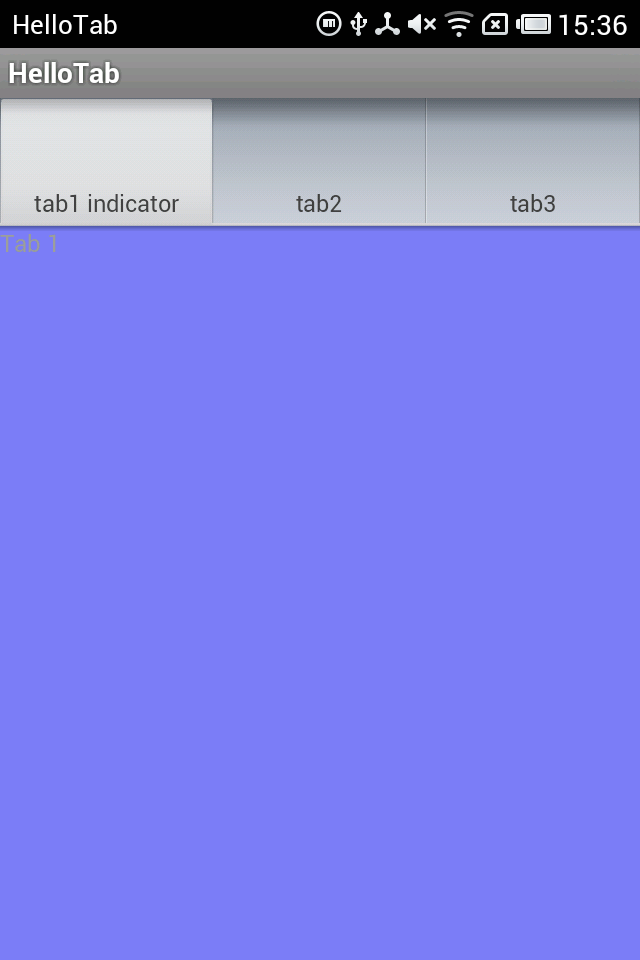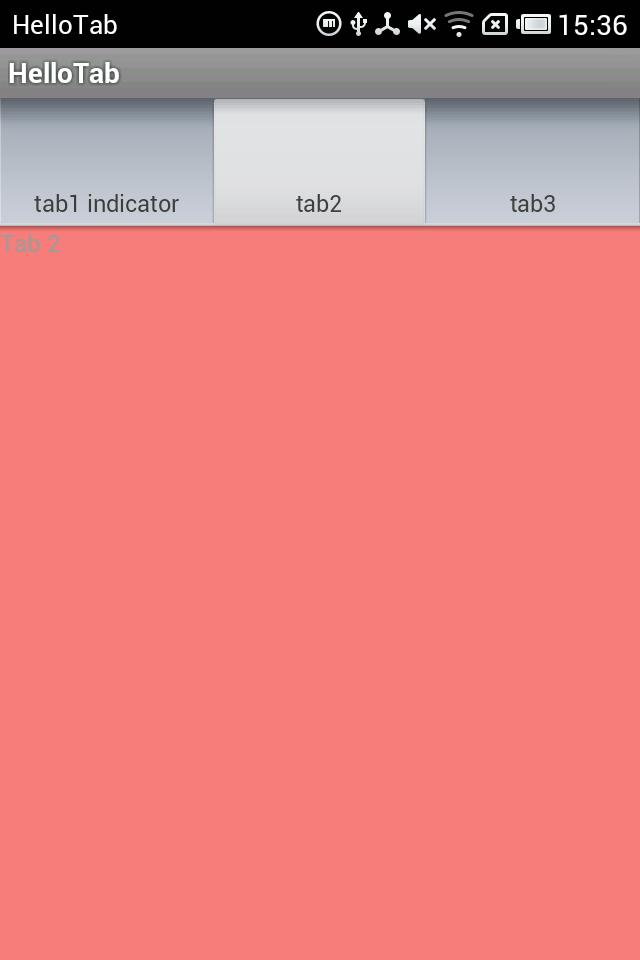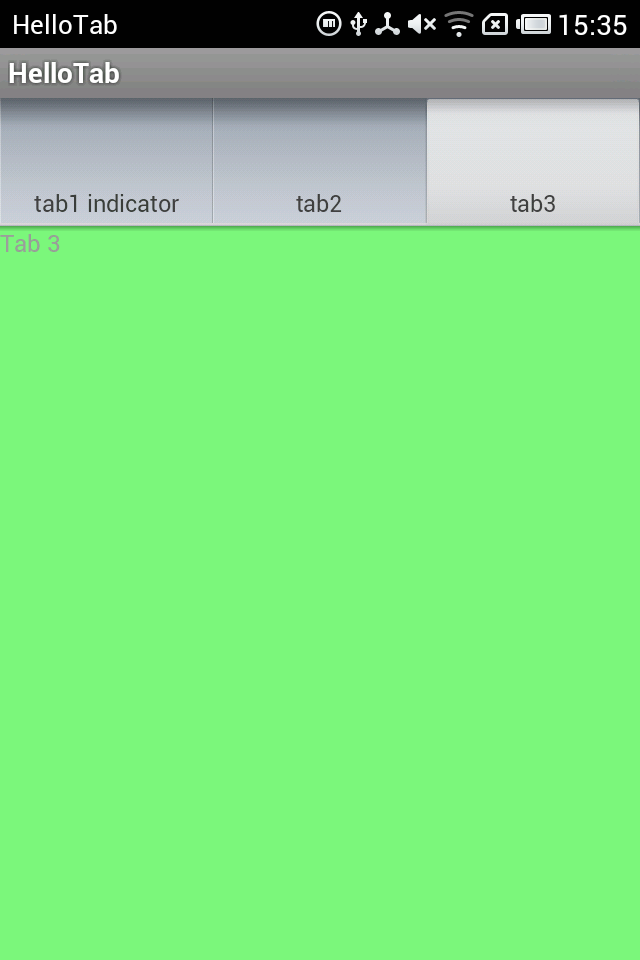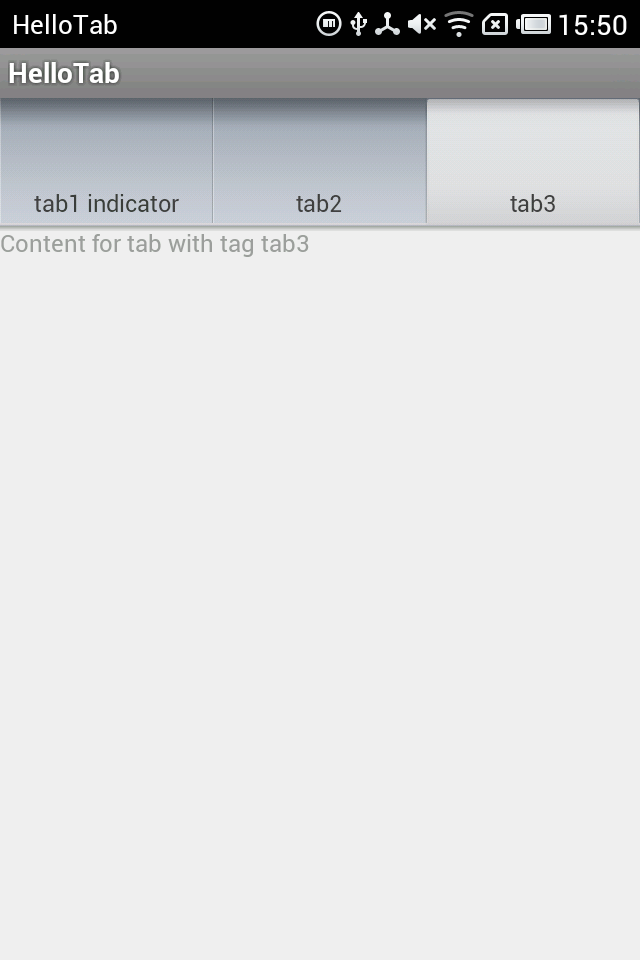Android Tab标签的使用基础
Android程序中,Tab标签窗口是一种常用的UI界面元素。它的实现主要是利用了TabHost类。
TabHost说明
TabHost是一个标签窗口的容器。
一个TabHost对象包含两个子元素对象:
一个对象是tab标签集合(TabWidget),用户点击它们来选择一个特定的标签;
另一个是FrameLayout对象,展示当前页的内容。
子元素通常是通过容器对象来控制,而不是直接设置子元素的值。
下面结合ApiDemos中的例子来说明TabHost的用法。
第一个Tab例子:使用TabActivity
这个例子使用了 TabActivity。
Java程序代码:
package com.meng.hellotab;
import android.os.Bundle;
import android.view.LayoutInflater;
import android.widget.TabHost;
import android.app.TabActivity;
@SuppressWarnings("deprecation")
public class HelloTabActivity extends TabActivity
{
@Override
protected void onCreate(Bundle savedInstanceState)
{
super.onCreate(savedInstanceState);
// 得到TabActivity中的TabHost对象
TabHost tabHost = getTabHost();
// 内容:采用布局文件中的布局
LayoutInflater.from(this).inflate(R.layout.activity_hello_tab,
tabHost.getTabContentView(), true);
// 加上标签
// 参数设置:新增的TabSpec的标签,标签中显示的字样
// setContent设置内容对应的View资源标号
tabHost.addTab(tabHost.newTabSpec("tab1")
.setIndicator("tab1 indicator").setContent(R.id.view1));
tabHost.addTab(tabHost.newTabSpec("tab3").setIndicator("tab2")
.setContent(R.id.view2));
tabHost.addTab(tabHost.newTabSpec("tab3").setIndicator("tab3")
.setContent(R.id.view3));
}
}
其中布局文件如下:
布局文件1
布局文件1
<?xml version="1.0" encoding="utf-8"?>
<FrameLayout xmlns:android="http://schemas.android.com/apk/res/android"
android:layout_width="match_parent"
android:layout_height="match_parent" >
<TextView
android:id="@+id/view1"
android:layout_width="match_parent"
android:layout_height="match_parent"
android:background="@drawable/blue"
android:text="@string/tab1" />
<TextView
android:id="@+id/view2"
android:layout_width="match_parent"
android:layout_height="match_parent"
android:background="@drawable/red"
android:text="@string/tab2" />
<TextView
android:id="@+id/view3"
android:layout_width="match_parent"
android:layout_height="match_parent"
android:background="@drawable/green"
android:text="@string/tab3" />
</FrameLayout>
布局文件中的颜色字符串如下:文本字符串略。
colors.xml <?xml version="1.0" encoding="utf-8"?> <resources> <drawable name="red">#7f00</drawable> <drawable name="blue">#770000ff</drawable> <drawable name="green">#7700ff00</drawable> <drawable name="yellow">#77ffff00</drawable> <drawable name="screen_background_black">#ff000000</drawable> <drawable name="translucent_background">#e0000000</drawable> <drawable name="transparent_background">#00000000</drawable> <color name="solid_red">#f00</color> <color name="solid_blue">#0000ff</color> <color name="solid_green">#f0f0</color> <color name="solid_yellow">#ffffff00</color> </resources>
运行截图:



注意 TabActivity这个类已经被标注为:This class was deprecated in API level 13。
第二个程序:使用TabHost.TabContentFactory
TabHost.TabContentFactory这个接口是用来在tab被选择时自己创建内容,而不是显示一个已经存在的view或者启动一个activity,这两种要用其他的方法。
具体实现见代码:
package com.meng.hellotab;
import android.os.Bundle;
import android.view.LayoutInflater;
import android.view.View;
import android.widget.TabHost;
import android.widget.TextView;
import android.app.TabActivity;
@SuppressWarnings("deprecation")
public class HelloTabActivity extends TabActivity implements
TabHost.TabContentFactory
{
@Override
protected void onCreate(Bundle savedInstanceState)
{
super.onCreate(savedInstanceState);
TabHost tabHost = getTabHost();
// 不再需要载入布局文件,如果此句不注释掉会导致content的重叠
// LayoutInflater.from(this).inflate(R.layout.activity_hello_tab,
// tabHost.getTabContentView(), true);
// setContent中传递this
tabHost.addTab(tabHost.newTabSpec("tab1")
.setIndicator("tab1 indicator").setContent(this));
tabHost.addTab(tabHost.newTabSpec("tab3").setIndicator("tab2")
.setContent(this));
tabHost.addTab(tabHost.newTabSpec("tab3").setIndicator("tab3")
.setContent(this));
}
// setContent的参数设为this时,从这个方法得到每一个Tab的内容(此次不用布局文件,用的话会重叠)
@Override
public View createTabContent(String tag)
{
// 参数: 这个方法会接受到被选择的tag的标签
final TextView tv = new TextView(this);
tv.setText("Content for tab with tag " + tag);
return tv;
}
}
程序运行截图:

另外,Tab的content的内容还可以启动另一个Activity,只要在setContent方法中传入一个Intent即可。
此部分不再介绍,可以参见ApiDemos中的Tabs3.java代码。
第三个程序:不继承TabActivity
前面两个程序例子中都是继承了TabActivity类,如果不继承它,需要自己写TabHost的布局,其中包含了两个必要的子元素:TabWidget和FrameLayout,其id都是固定值,见代码。
布局文件代码:
<?xml version="1.0" encoding="utf-8"?>
<LinearLayout xmlns:android="http://schemas.android.com/apk/res/android"
android:layout_width="match_parent"
android:layout_height="match_parent"
android:orientation="vertical" >
<TextView
android:layout_width="wrap_content"
android:layout_height="wrap_content"
android:text="@string/hello_world" />
<!-- TabHost必须包含一个 TabWidget和一个FrameLayout -->
<TabHost
android:id="@+id/myTabHost"
android:layout_width="match_parent"
android:layout_height="match_parent" >
<LinearLayout
android:layout_width="fill_parent"
android:layout_height="fill_parent"
android:orientation="vertical" >
<!-- TabWidget的id属性必须为 @android:id/tabs -->
<TabWidget
android:id="@android:id/tabs"
android:layout_width="match_parent"
android:layout_height="wrap_content"
android:layout_weight="0"
android:orientation="horizontal" />
<!-- FrameLayout的id属性必须为 @android:id/tabcontent -->
<FrameLayout
android:id="@android:id/tabcontent"
android:layout_width="match_parent"
android:layout_height="match_parent"
android:layout_weight="0" >
<TextView
android:id="@+id/view1"
android:layout_width="match_parent"
android:layout_height="match_parent"
android:text="Tab1 Content" />
<TextView
android:id="@+id/view2"
android:layout_width="match_parent"
android:layout_height="match_parent"
android:text="Tab2 Content" />
<TextView
android:id="@+id/view3"
android:layout_width="match_parent"
android:layout_height="match_parent"
android:text="Tab3 Content" />
</FrameLayout>
</LinearLayout>
</TabHost>
</LinearLayout>
Activity代码:
package com.meng.hellotabhost;
import android.os.Bundle;
import android.app.Activity;
import android.view.Menu;
import android.widget.TabHost;
public class HelloTabHostActivity extends Activity
{
@Override
protected void onCreate(Bundle savedInstanceState)
{
super.onCreate(savedInstanceState);
setContentView(R.layout.activity_hello_tab_host);
TabHost tabHost = (TabHost) findViewById(R.id.myTabHost);
// 如果不是继承TabActivity,则必须在得到tabHost之后,添加标签之前调用tabHost.setup()
tabHost.setup();
// 这里content的设置采用了布局文件中的view
tabHost.addTab(tabHost.newTabSpec("tab1")
.setIndicator("tab1 indicator").setContent(R.id.view1));
tabHost.addTab(tabHost.newTabSpec("tab3").setIndicator("tab2")
.setContent(R.id.view2));
tabHost.addTab(tabHost.newTabSpec("tab3").setIndicator("tab3")
.setContent(R.id.view3));
}
}
这种方式可以实现比较灵活的布局,可以方便地加入其他组件,还可以改变标签栏和内容栏的相对位置。
第四个程序:scrolling Tab
当标签太多时,需要把标签设置进一个ScrollView中进行滚动。有了上面的程序做基础,这个很好理解。
ApiDemos中给出的仍然是继承TabActivity的方法,在这里给出另一种不用继承TabActivity的方法,两种方法很类似。
布局文件:
<?xml version="1.0" encoding="utf-8"?>
<LinearLayout xmlns:android="http://schemas.android.com/apk/res/android"
android:layout_width="match_parent"
android:layout_height="match_parent"
android:orientation="vertical" >
<TabHost
android:id="@+id/myTabHost"
android:layout_width="match_parent"
android:layout_height="match_parent" >
<LinearLayout
android:layout_width="match_parent"
android:layout_height="match_parent"
android:orientation="vertical"
android:padding="5dp" >
<HorizontalScrollView
android:layout_width="match_parent"
android:layout_height="wrap_content"
android:scrollbars="none" >
<TabWidget
android:id="@android:id/tabs"
android:layout_width="wrap_content"
android:layout_height="wrap_content" />
</HorizontalScrollView>
<FrameLayout
android:id="@android:id/tabcontent"
android:layout_width="match_parent"
android:layout_height="match_parent"
android:padding="5dp" />
</LinearLayout>
</TabHost>
</LinearLayout>
Java代码:
package com.meng.hellotabscroll;
import android.os.Bundle;
import android.app.Activity;
import android.view.View;
import android.widget.TabHost;
import android.widget.TextView;
public class HelloTabScrollActivity extends Activity implements
TabHost.TabContentFactory
{
@Override
protected void onCreate(Bundle savedInstanceState)
{
super.onCreate(savedInstanceState);
setContentView(R.layout.activity_hello_tab_scroll);
// 从布局中获取TabHost并建立
TabHost tabHost = (TabHost) findViewById(R.id.myTabHost);
tabHost.setup();
// 加上30个标签
for (int i = 1; i <= 30; i++)
{
String name = "Tab " + i;
tabHost.addTab(tabHost.newTabSpec(name).setIndicator(name)
.setContent(this));
}
}
@Override
public View createTabContent(String tag)
{
final TextView tv = new TextView(this);
tv.setText("Content for tab with tag " + tag);
return tv;
}
}
以上就是本文的全部内容,希望对大家的学习有所帮助,也希望大家多多支持我们。

